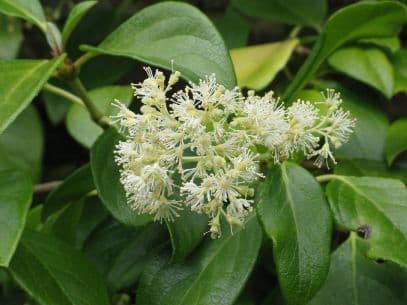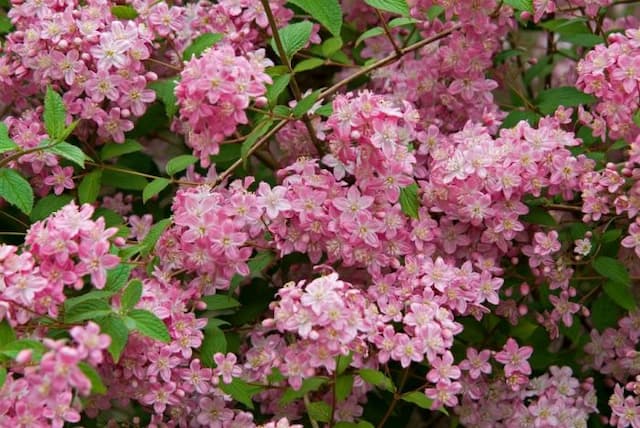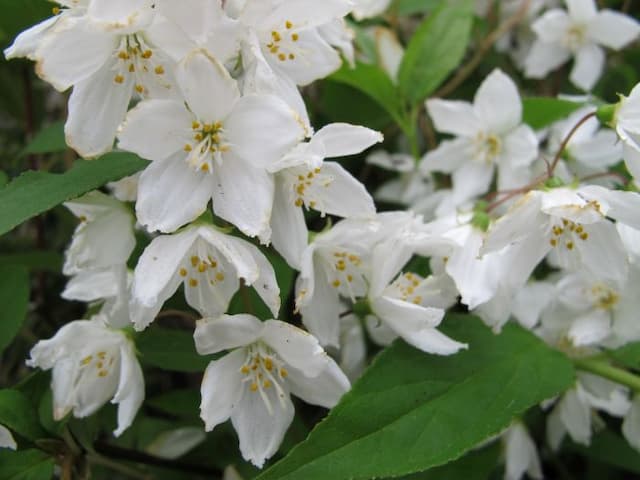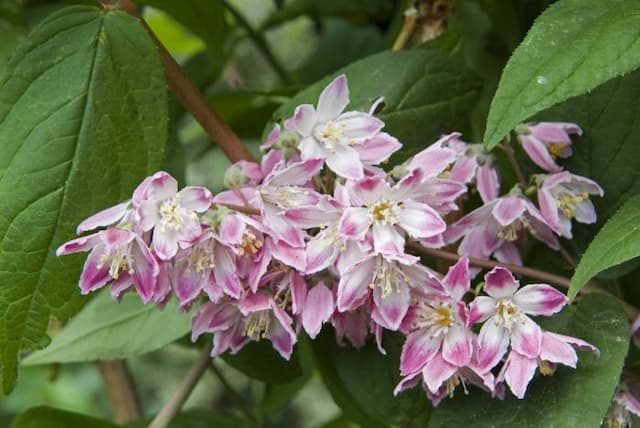Bigleaf Hydrangea Hydrangea macrophylla 'King George' (H)

ABOUT
Hydrangea 'King George' is notable for its large, rounded clusters of flowers, which can be very showy and are often used as a focal point in gardens. These flowers bloom in a variety of colors, which can range from pink to blue, often depending on the soil acidity. Rich, green foliage provides a lush backdrop for the voluminous flower heads, which appear in late spring to summer. The leaves are broad with a slightly serrated edge and can create a dense, leafy appearance for the shrub. The stems of the plant are sturdy, supporting the weight of the flowers well, and the bush itself maintains a rounded, bushy habit. When in bloom, Hydrangea 'King George' can create a spectacular display of color and texture, making it a favorite among garden enthusiasts who seek to add a dramatic flourish to their plantings. The flowers have the potential to dry well, making them popular for use in dried flower arrangements after their initial fresh bloom period. Overall, the appearance of this hydrangea cultivar is one of abundance and vibrant color, with a dense, green framework that stays attractive throughout the growing season.
About this plant
 Names
NamesFamily
Hydrangeaceae
Synonyms
Bigleaf Hydrangea, French Hydrangea, Lacecap Hydrangea, Mophead Hydrangea, Hortensia
Common names
Hydrangea macrophylla 'King George' (H).
 Toxicity
ToxicityTo humans
Hydrangea, the common name for Hydrangea macrophylla 'King George', can be toxic to humans if ingested. The plant contains compounds called cyanogenic glycosides, which can release cyanide in the body when chewed or digested. Symptoms of hydrangea poisoning may include gastrointestinal upset, such as vomiting and diarrhea, along with possible dizziness and confusion due to the cyanide's effect on oxygen transport within the body. Ingesting large quantities can be more severe and may require medical attention due to the risk of cyanide toxicity.
To pets
Hydrangea, also known as Hydrangea macrophylla 'King George' to pets, can exhibit toxicity if ingested. Cyanogenic glycosides present in the plant can produce cyanide in the body, leading to symptoms ranging from mild to severe. These may include vomiting, diarrhea, lethargy, and depression. In more serious cases, pets might experience increased heart rate and respiratory distress. Cyanide inhibits oxygen transport, which can lead to asphyxiation at toxic levels. If ingestion occurs, it is important for the pet to receive veterinary care promptly.
 Characteristics
CharacteristicsLife cycle
Perennials
Foliage type
Deciduous
Color of leaves
Green
Flower color
Varies
Height
4-6 feet (1.2-1.8 meters)
Spread
4-6 feet (1.2-1.8 meters)
Plant type
Shrub
Hardiness zones
6
Native area
Japan
Benefits
 General Benefits
General Benefits- Landscape Aesthetics: Adds visual interest with its large, showy flower heads that bloom in a variety of colors from pink to blue, depending on soil pH.
- Seasonal Interest: Offers a lengthy blooming period from early spring to late fall, providing long-term color to gardens.
- Pollinator Attraction: Attracts bees and butterflies, which are essential for pollination and maintaining biodiversity.
- Erosion Control: The shrub's extensive root system can help in stabilizing soil and preventing erosion in the garden.
- Versatility: Suitable for a range of garden styles including formal, cottage, and woodland plantings.
- Privacy & Screening: Can be used as a hedge or screening plant to create privacy within gardens and landscapes.
- Shade Tolerance: Capable of growing in partial shade, providing options for underplanting beneath canopy trees.
- Soil Adaptability: Adapts to a range of soil types, though it prefers moist, well-drained conditions.
- Cut Flowers: Blooms can be used as cut flowers for indoor arrangements, maintaining their color well when cut.
- Propagation: Easily propagated by cuttings, allowing gardeners to create new plants for other areas or to share with friends.
 Medical Properties
Medical PropertiesThis plant is not used for medical purposes.
 Air-purifying Qualities
Air-purifying QualitiesThis plant is not specifically known for air purifying qualities.
 Other Uses
Other Uses- Hydrangea as a pH indicator: The colors of the flowers can indicate the acidity or alkalinity of the soil, with pink flowers suggesting alkaline conditions and blue flowers indicating acidic soil.
- Preserved blooms for crafts: The flowers of the hydrangea can be dried and preserved for use in wreaths, bouquets, or other decorative craft projects.
- Colorant in fabric dyeing: The blooms can be used as a natural dye source for fabrics, providing a range of colors from pale green to soft blues and pinks, depending on the mordant used.
- Watercolor painting: Crushed hydrangea petals can provide a natural pigment for watercolor paints, adding unique hues to the artist’s palette.
- Garden design for visual cooling: The lush foliage and cool-colored blooms of the hydrangea can create a perceived cooling effect in garden landscapes, especially useful in warmer climates.
- Floral photography subject: With their intricate structure, hydrangeas are popular subjects for photographers looking to capture the beauty of flowers in close-up or macro photography.
- Luck and prosperity symbol: In some cultures, giving hydrangeas is thought to express a wish for the receiver’s good fortune and abundance in life.
- Education and study: Botany students and plant enthusiasts use hydrangeas to study plant propagation and breeding due to their interesting genetic color variations.
- Culinary decoration: While not edible, the flowers can be used to adorn plates or buffet tables in high-end culinary presentations, providing an aesthetically pleasing touch.
- Feng Shui application: Some practitioners believe placing hydrangeas in certain areas of the home or garden can positively influence the flow of energy as per Feng Shui principles.
Interesting Facts
 Feng Shui
Feng ShuiThe Hydrangea is not used in Feng Shui practice.
 Zodiac Sign Compitability
Zodiac Sign CompitabilityThe Hydrangea is not used in astrology practice.
 Plant Symbolism
Plant Symbolism- Heartfelt Emotions: Hydrangeas are often used to express genuine, deep emotions and can symbolize heartfelt gratitude or apology.
- Vanity or Frivolity: In some traditions, the hydrangea represents vanity or boastfulness due to its showy blooms and ability to change color based on the soil pH.
- Understanding: The complexity of the hydrangea's blooms is sometimes linked to a message of understanding and patient listening.
- Abundance: With its lush and voluminous flower heads, the hydrangea can symbolize abundance and prosperity.
- Perseverance: As the hydrangea can thrive in a variety of conditions, it is frequently seen as a symbol of perseverance and resilience.
 Water
WaterBigleaf hydrangeas, which includes Hydrangea macrophylla 'King George', prefer consistently moist soil, so it's important to water them deeply and thoroughly. During the growing season, they typically require watering once or twice a week depending on the weather conditions—more frequently during dry spells and less during rainy periods. Aim to apply about 1 gallon of water per plant each time you water, ensuring the moisture reaches deep into the root zone. During hot summer days, they may need additional water to prevent wilting, but be cautious of overwatering, as this can lead to root rot.
 Light
LightBigleaf hydrangeas thrive in a spot that receives morning sun and afternoon shade, making this the best lighting condition for Hydrangea macrophylla 'King George'. Avoiding the intense afternoon sun is crucial for protecting the leaves and flowers from scorch. A north or east-facing location often provides the balance of light these hydrangeas need for optimal growth and flowering.
 Temperature
TemperatureThe ideal temperature range for Bigleaf hydrangeas, such as Hydrangea macrophylla 'King George', is between 65°F and 75°F. These plants can tolerate a minimum temperature of around 50°F, but frost can damage the delicate flower buds. Maximum temperature tolerance is about 80°F to 85°F; above this range, the plants may stress and require additional shade and water to stay healthy.
 Pruning
PruningPrune Bigleaf hydrangeas, such as Hydrangea macrophylla 'King George', to remove dead wood and to shape the plant after the flowers fade in late summer or early fall. These hydrangeas bloom on old wood, so pruning in late winter or early spring can remove flower buds and diminish blooming. Annual pruning is typically sufficient to maintain a tidy appearance and encourage healthy growth and ample flowering for the next season.
 Cleaning
CleaningAs needed
 Soil
SoilBigleaf hydrangeas thrive in moist, well-draining soil with high organic content. A good mix would be equal parts garden soil, peat moss, and perlite or coarse sand to ensure proper drainage. The ideal pH for the soil should be around 5.5 to 6.5 to maintain a blue flower color, or closer to neutral to alkaline (6.5-7.5) for pink blooms.
 Repotting
RepottingBigleaf hydrangeas should be repotted every 2-3 years to ensure they have enough space for root growth and to replenish the soil nutrients. Spring or early fall is the best time for repotting to allow the plant to establish before extreme weather.
 Humidity & Misting
Humidity & MistingThe ideal humidity level for Bigleaf hydrangeas is between 60-70%. They enjoy moist air and will appreciate regular misting or a humid environment, particularly in dry indoor conditions.
 Suitable locations
Suitable locationsIndoor
Place in bright, indirect light with high humidity.
Outdoor
Plant in part shade, shelter from strong winds, ensure soil stays moist.
Hardiness zone
6-9 USDA
 Life cycle
Life cycleThe life of Hydrangea macrophylla 'King George', commonly known as Bigleaf hydrangea, begins with seed germination, which occurs in moist, fertile soil with partial to full sunlight exposure. Following germination, the seedling emerges and develops into a juvenile plant, growing leaves and roots as it becomes established. After establishment, the hydrangea enters its vegetative growth phase, wherein it produces large, serrated leaves and stout stems. The plant then reaches maturity and enters the reproductive stage, characterized by the development of large, showy flower heads, typically in shades of blue, pink, or white, depending on soil pH. After the flowering period, which occurs in late spring to early summer, the plant sets seeds that are then dispersed by wind or wildlife. During the winter or in response to environmental stress, the hydrangea may enter a period of dormancy, shedding leaves and conserving resources until favorable conditions return for the next growth cycle.
 Propogation
PropogationPropogation time
Spring to Summer
The most popular method of propagation for the Hydrangea, specifically the Hydrangea macrophylla 'King George', is through softwood or semi-hardwood cuttings. This typically occurs during late spring or early summer when the plant's new growth is still green and flexible but beginning to mature and harden slightly. To propagate, one must cut a 4 to 6 inch (10 to 15 cm) long stem from a healthy part of the plant, making the cut just below a leaf node. The lower leaves should be removed and the cut end can be dipped in rooting hormone to encourage root development. The prepared cutting should then be planted in a pot filled with moist potting mix and placed in a warm spot with bright, indirect light. Covering the pot with a plastic bag helps maintain humidity around the cutting, creating favorable conditions for root growth. With consistent moisture and occasional misting, roots should form within a few weeks, after which the new hydrangea plant can gradually acclimate to normal conditions before planting in the garden.






![Rose deutzia [Yuki Cherry Blossom]](/_next/image?url=https%3A%2F%2Fplants-admin.emdemapps.com%2Fimages%2Fplants%2F%2Fimages%2F604b6510a383a.png&w=640&q=75)

![Hydrangea [Hot Chocolate]](/_next/image?url=https%3A%2F%2Fplants-admin.emdemapps.com%2Fimages%2Fplants%2F%2Fimages%2F604b5a066e3bd.png&w=640&q=75)
![Hydrangea [Blackberry Pie]](/_next/image?url=https%3A%2F%2Fplants-admin.emdemapps.com%2Fimages%2Fplants%2F%2Fimages%2F604b56e2abc1d.png&w=640&q=75)